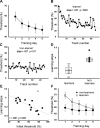Neural correlates of perceptual learning in the auditory brainstem: efferent activity predicts and reflects improvement at a speech-in-noise discrimination task
- PMID: 18463246
- PMCID: PMC6670751
- DOI: 10.1523/JNEUROSCI.0902-08.2008
Neural correlates of perceptual learning in the auditory brainstem: efferent activity predicts and reflects improvement at a speech-in-noise discrimination task
Abstract
An extensive corticofugal system extends from the auditory cortex toward subcortical nuclei along the auditory pathway. Corticofugal influences reach even into the inner ear via the efferents of the olivocochlear bundle, the medial branch of which modulates preneural sound amplification gain. This corticofugal system is thought to contribute to neuroplasticity underlying auditory perceptual learning. In the present study, we investigated the involvement of the medial olivocochlear bundle (MOCB) in perceptual learning as a result of auditory training. MOCB activity was monitored in normal-hearing adult listeners during a 5 d training regimen on a consonant-vowel phoneme-in-noise discrimination task. The results show significant group learning, with great inter-individual variability in initial performance and improvement. As observed in previous auditory training studies, poor initial performers tended to show greater learning. Strikingly, MOCB activity measured on the first training day strongly predicted the subsequent amount of improvement, such that weaker initial MOCB activity was associated with greater improvement. Moreover, in listeners that improved significantly, an increase in MOCB activity was observed after training. Thus, as discrimination thresholds of listeners converged over the course of training, differences in MOCB activity between listeners decreased. Additional analysis showed that MOCB activity did not explain variation in performance between listeners on any training day but rather reflected an individual listener's performance relative to their personal optimal range. The findings suggest an MOCB-mediated listening strategy that facilitates speech-in-noise perception. The operation of this strategy is flexible and susceptible to training, presumably because of task-related adaptation of descending control from the cortex.
Figures



References
-
- Ahissar M, Hochstein S. The reverse hierarchy theory of visual perceptual learning. Trends Cogn Sci. 2004;8:457–464. - PubMed
-
- Alain C, Snyder JS, He Y, Reinke KS. Changes in auditory cortex parallel rapid perceptual learning. Cereb Cortex. 2007;17:1074–1084. - PubMed
-
- Amitay S, Hawkey DJ, Moore DR. Auditory frequency discrimination learning is affected by stimulus variability. Percept Psychophys. 2005;67:691–698. - PubMed
-
- Bao S, Chang EF, Woods J, Merzenich MM. Temporal plasticity in the primary auditory cortex induced by operant perceptual learning. Nat Neurosci. 2004;7:974–981. - PubMed
MeSH terms
Grants and funding
LinkOut - more resources
Full Text Sources
Medical
Research Materials
